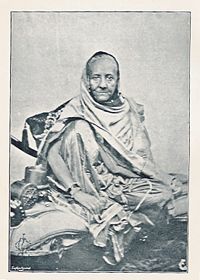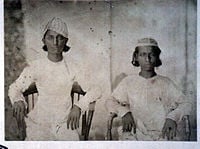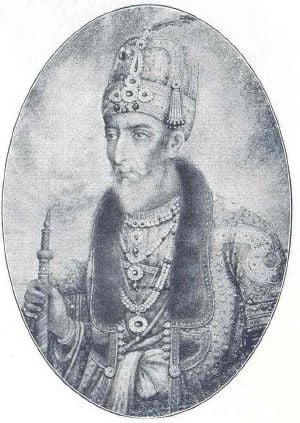Bahadur Shah II
| 'Abu Zafar Sirajuddin Muhammad Bahadur Shah Zafar ابو ظفر سِراجُ الْدین محمد بُہادر شاہ ظفر' | ||
|---|---|---|
| Emperor of the Mughal Empire | ||
| Reign | September 28, 1838 – September 14, 1857 | |
| Titles | بُہادر شاہ دوم ; Mughal Emperor | |
| Born | October 24,1775 | |
| Delhi, Mughal Empire | ||
| Died | November 7, 1862 | |
| Rangoon, Burma, British Raj | ||
| Buried | Rangoon, Burma | |
| Predecessor | Akbar Shah II | |
| Successor | Mughal Empire abolished Descendants: 22 sons and at least 32 daughters | |
| Father | Akbar Shah II | |
| Mother | Lalbai | |
Abu Zafar Sirajuddin Muhammad Bahadur Shah Zafar (Urdu: ابو ظفر سِراجُ الْدین محمد بُہادر شاہ ظفر), also known as Bahadur Shah or Bahadur Shah II (Urdu: بُہادر شاہ دوم; October 24 1775 – 7 November 1862) was the last of the Mughal emperors in India, as well as the last ruler of the Timurid Dynasty . He was the son of Akbar Shah II by his Hindu wife Lalbai. He became the Mughal Emperor upon his father's death on September 28, 1838. Zafar (Urdu: ظفر) was his nom de plume (takhallus) as an Urdu poet.
As emperor
Bahadur Shah presided over a Mughal empire that barely extended beyond Delhi's Red Fort. The British Raj was the dominant political and military powers in 19th-century India. Hundreds of minor principalities fragmented the land. The emperor was paid some respect and allowed a pension and authority to collect some taxes, and maintain a token force in Delhi, but he posed no threat to any power in India. Bahadur Shah II himself did not interest himself in statecraft or possess any imperial ambitions.
Bahadur Shah Zafar was a noted Urdu poet. He wrote a large number of Urdu ghazals. While some part of his opus was lost or destroyed during the unrest of 1857-1858, a large collection did survive, and was later compiled into the Kulliyyat-i Zafar. The court that he maintained, although somewhat decadent and arguably pretentious for someone who was effectively a pensioner of the British East India Company, was home to several Urdu writers of high standing, including Ghalib, Dagh, Mumin, and Zauq (Dhawq).
Events of 1857
As the Indian rebellion of 1857 spread, the Indian regiments seized Delhi and acclaimed Zafar their nominal leader, despite his own reservations. Zafar was viewed as a figure who could unite all Indians, Hindu and Muslim alike, and someone who would be acceptable to the Indian princes as sovereign. Zafar was the least threatening and least ambitious of monarchs, and the relict of the Mughal Empire would presumably be more acceptable as a uniting force to these rulers than the domination of any other Indian kingdom.
When the victory of the British became certain, Zafar took refuge at Humayun's Tomb, in an area that was then at the outskirts of Delhi, and hid there. British forces led by Major Hodson surrounded the tomb and compelled his surrender. Numerous male members of his family were killed by the British, who imprisoned or exiled the surviving members of the Mughal dynasty. Zafar himself was exiled to Rangoon, Burma (now Yangon, Myanmar) in 1858 along with his wife Zeenat Mahal and some of the remaining members of the family. His departure as Emperor marked the end of more than three centuries of Mughal rule in India.
Bahadur Shah died in exile on November 7, 1862. He was buried near the Shwedagon Pagoda in Yangon, at the site that later became known as Bahadur Shah Zafar Dargah.[1] His wife Zinat Mahal died in 1886.[2]
Legacy
Modern India views him as one of its first nationalists, someone who actively opposed British rule in India. In 1959, the All India Bahadur Shah Zafar Academy was founded expressly to spread awareness about his contribution to the first national freedom movement of India. Several movies in Hindi/Urdu have depicted his role during the rebellion of 1857. There are roads bearing his name in New Delhi, Lahore, Varanasi and other cities. A statue of Bahadur Shah Zafar has been erected at Vijayanagaram palace in Varanasi. In Bangladesh, the Victoria Park of old Dhaka has been renamed as Bahadur Shah Zafar Park.
Family
Bahadur Shah Zafar is known to have had four wives and numerous concubines. In order of marriage, his wives were: [3]
- Begum Ashraf Mahal
- Begum Akhtar Mahal
- Begum Zeenat Mahal
- Begum Taj Mahal
Zafar had 22 sons, including:
- Mirza Fath-ul-Mulk Bahadur (alias Mirza Fakhru)
- Mirza Mughal
- Mirza Khazr Sultan
- Jawan Bakht
- Mirza Quaish
- Mirza Shah Abbas
He also had at least 32 daughters, including:
- Rabeya Begum
- Begum Fatima Sultan
- Kulsum Zamani Begum
- Raunaq Zamani Begum (possibly a granddaughter)
Most of his sons and grandsons were killed during or in the aftermath of the rebellion of 1857. Of those who survived, the following three lines of descent are known:
- Delhi line — son: Mirza Fath-ul-Mulk Bahadur (alias Mirza Fakhru); grandson: Mirza Farkhunda Jamal; great-grandchildren: Hamid Shah and Begum Qamar Sultan.
- Howrah line — son: Jawan Bakht, grandson: Jamshid Bakht, great-grandson: Mirza Muhammad Bedar Bakht (married Sultana Begum, who currently runs a tea stall in Howrah).
- Hyderabad line — son: Mirza Quaish, grandson: Mirza Abdullah, great-grandson: Mirza Pyare (married Habib Begum), great-great-granddaughter: Begum Laila Ummahani (married Yakub Habeebuddin Tucy).
<---Descendants of Mughal rulers other than Bahadur Shah Zafar also survive to this day. They include the line of Jalaluddin Mirza in Bengal, who served at the court of the Maharaja of Dighapatia, and the Toluqari family, which claims to be descended from Baron Gardner as well. ---!>
Epitaph
The following famous poem was written by Bahadur Shah Zafar as his epitaph; this is an English translation.
| Original | English Translation |
|---|---|
|
|
In his book, The Last Mughal, William Dalrymple states that according to Lahore scholar Imran Khan (and others), this verse and the equally popular Na kisi ki aankh ka noor hoon were not written by Zafar and do not appear in any of the works published during Zafar's lifetime.
Another verse reads:
| “ |
Zafar, no matter how smart and witty one may be, he is not a man |
” |
See also
- Mughal Emperor
- Urdu poetry
- List of Indian monarchs
- List of Urdu poets
- Indian rebellion of 1857Italic text'his famous poetry in his last days is
KITNA BADNASEEB HAI ZAFER DAFEN KE LIYE
TWO GUZ ZAMEEN BHI NA MILLI QUYE YAAR MEIN
in english
how pitiful is your fate O Zafar for your burial
you couldn't even find two yards in your motherland
Notes
- ↑ The Dargah of Bahadur Shah Zafar in Rangoon.
- ↑ Nawab Zeenat Mahal
- ↑ Farooqi, Abdullah. accessdate=2007-07-22 Bahadur Shah Zafar Ka Afsanae Gam. Farooqi Book Depot.
- ↑ BBC
- ↑ Jee Nehein Lagta Ujrey Diyaar Mein. http://www.urdupoint.com.+Retrieved 2007-07-21.
ReferencesISBN links support NWE through referral fees
- Ahmed, Syed Z. 1996. Twilight of an empire. Lahore: Ferozsons.ISBN 9789690102140
- Burke, S. M., and Salim al-Din Quraishi. 1995. Bahadur Shah: the last Moghul emperor of India. Lahore: Sang-e-Meel ISBN 9789693506266
- Dalrymple, William. 2007. The last Mughal: the fall of a dynasty : Delhi, 1857. New York: Alfred A. Knopf ISBN 9781400043101
- Garrett, H. L. O. 2003. The trial of Muhammad Bahadur Shah, ex. king of Delhi. Lahore: Research and Publication Centre, National College of Arts ISBN 9789698623036
- Husain, Syed Mahdi. 2006. Bahadur Shah Zafar and the war of 1857 in Dehli. Dehli: Aakar Books ISBN 9788187879916
- Nayar, Pramod K. 2007. The trial of Bahadur Shah Zafar. Hyderabad, India: Orient Longman ISBN 9788125032700
External links
- Bahadur Shah Zafar at Kavita Kosh
- BBC Report on Bahadur Shah's possible descendants in Hyderabad
- An article on Bahadur Shah's descendants in Delhi and Hyderabad
- Another article on Bahadur Shah's descendants in Hyderabad
- An article on Bahadur Shah's descendants in Kolkata
- Forgotten Empress: Sultana Beghum sells tea in Kolkata
- Extracts from a book on Bahadur Shah Zafar, with details of exile and family
- Links to further websites on Bahadur Shah Zafar
- Poetry on urdupoetry.com
- Extract of talk by Zafar's biographer William Dalrymple (British Library)
| Preceded by: Akbar Shah II |
Mughal Emperor 1837–1858 |
Succeeded by: Mughal Empire abolished |
| Emperors: | Babur - Humayun - Akbar - Jahangir - Shah Jahan - Aurangzeb - Lesser Mughals |
| Events: | First battle of Panipat - Second battle of Panipat - Third battle of Panipat |
| Architecture: | Humayun's Tomb - Agra Fort - Badshahi Mosque - Lahore Fort - Red Fort - Taj Mahal - Shalimar Gardens - Pearl Mosque - Bibi Ka Maqbara - See also |
| Adversaries: | Ibrahim Lodhi - Sher Shah Suri - Hemu - Shivaji - Guru Gobind Singh |
ar:بهادور شاه الثاني bn:বাহাদুর শাহ জাফর de:Bahadur Shah II. fr:Muhammad Bahâdur Shâh hi:बहादुर शाह ज़फ़र ml:ബഹദൂര് ഷാ സഫര് ja:バハードゥル・シャー2世 uz:Bahodir-shoh II fi:Bahadur Shah II sv:Bahadur Shah II ur:بہادر شاہ ظفر zh:穆罕默德·巴哈杜尔·沙·扎法
Credits
New World Encyclopedia writers and editors rewrote and completed the Wikipedia article in accordance with New World Encyclopedia standards. This article abides by terms of the Creative Commons CC-by-sa 3.0 License (CC-by-sa), which may be used and disseminated with proper attribution. Credit is due under the terms of this license that can reference both the New World Encyclopedia contributors and the selfless volunteer contributors of the Wikimedia Foundation. To cite this article click here for a list of acceptable citing formats.The history of earlier contributions by wikipedians is accessible to researchers here:
The history of this article since it was imported to New World Encyclopedia:
Note: Some restrictions may apply to use of individual images which are separately licensed.


